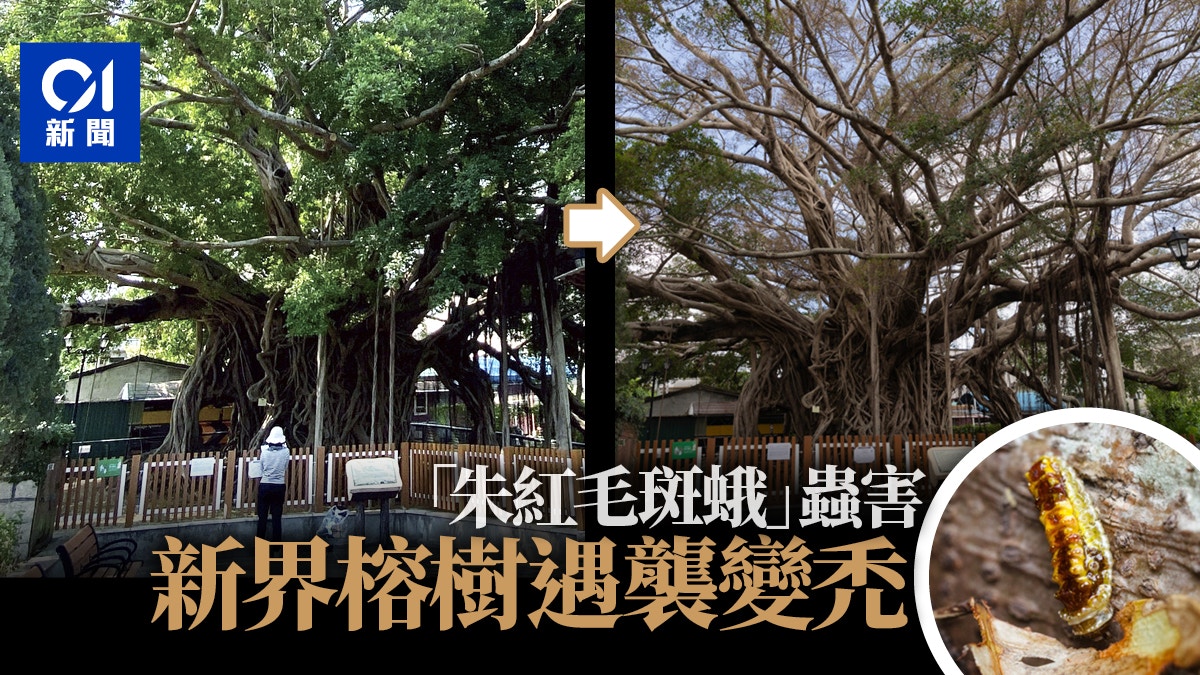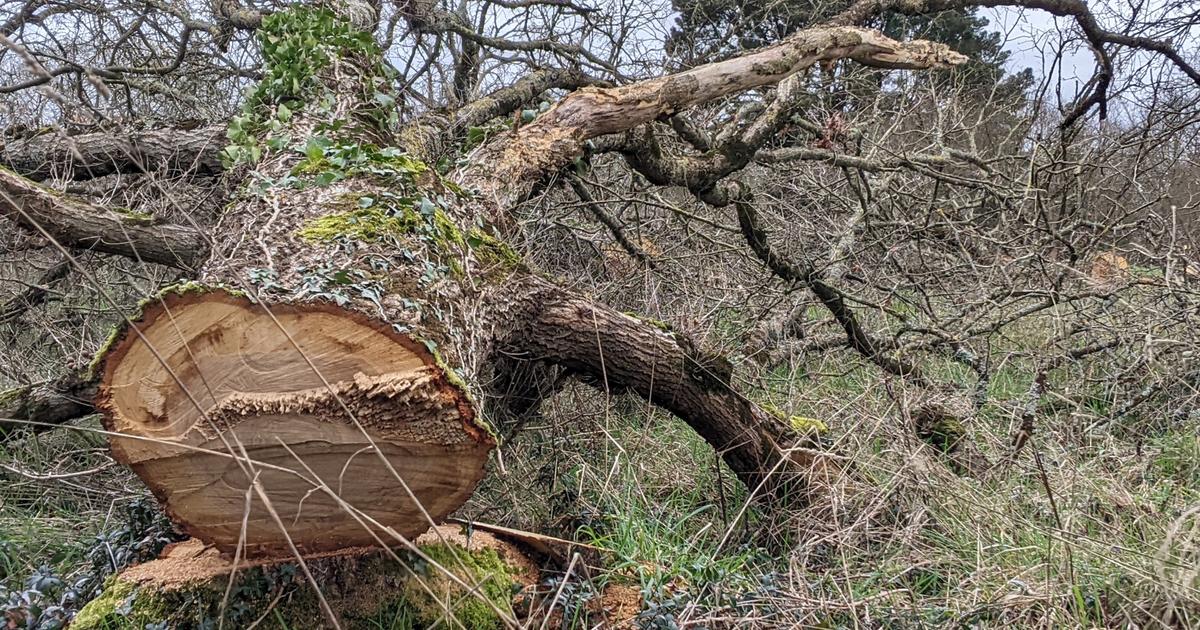Social News
Written by: Lao Minyi
2021-05-30 00:00
Last update date: 2021-05-30 00:00
A large-scale outbreak of the "Vermillion Moth" pests occurred in Hong Kong at the end of last year. Banyan trees in many parts of the New Territories were hit by the disaster. The larvae that feed on the leaves of the banyan trees almost gnawed the crown of the tree to bald.
In May of this year, this bare "landscape" reappeared. Centuries-old banyan trees such as Kam Tin Tree House and Lam Tsuen Wishing Tree could not escape the "moth plague". Among them, Sheung Shui Garden (No. 1) has about 30 thin trees in the garden. The leaves of the banyan are even more eaten by the larvae.
Concerned groups worry that due to global warming, severe pests have increased to three times a year, making it more difficult for banyan trees to repair themselves 100%. In addition, Hong Kong was drier at the beginning of this year, and some banyan trees infected with brown root disease were trapped inside and outside. Down, it will only go from bad to worse.
The Development Bureau also admitted that the number of trees affected by the larvae of Vermillion Moth has increased this year compared to previous years, including 23 banyan trees in the Register of Ancient and Valuable Trees.
[Extended reading]
Banyan moth plagues | Tree trunks wrapped in straw mats, linen bags and insect catching experts promote the removal of insect pupae to prevent large outbreaks
Banyan moth plague: Four ancient trees suffering from "tree cancer" are trapped by insect pests
▼The vermilion moth broke out again in the New Territories.
+11
+11
+11
Last year, the Changchun News Agency discovered an outbreak of the "Vermillion Moth" in Hong Kong. In the evergreen banyan tree, a large number of leaves were eaten by moths, leaving only scattered green leaves.
Moth tracks are found in many districts in the New Territories, including Tuen Mun, Tin Shui Wai, Kam Tin, Yuen Long, Sheung Shui, etc.
There are also signs of moths spreading in Tai Po District this year. The local district councillors pointed out that the larvae were found in banyan trees near Tai Wo Village, Tai Po Old Market Cui Yi Street, Po Nga Court and Hong Yuen Garden.
According to the observation of the Changchun News Agency, the banyan trees in Taihe Village lost at least less than 10% of their leaves. This is the initial stage of the "moth disaster", while the Kowloon and Hong Kong Island areas have not yet fallen.
Xu Shujun, conservation manager of the Changchun Society, said that after a dry winter, many banyan trees have almost recovered 90% in March this year. At that time, the moths of the overwintering generation gradually emerged and turned into insects (ie moths), flying to the top of the tree to mate and lay eggs. After 10 to 20 days, the last generation of moths from last year had hatched at the end of March, which appeared a month earlier than in previous years.
Moths "start their meals" from the top of the tree and gradually eat down the leaves, even the phloem of the branches.
The larvae of the vermillion moth are gradually "eating". In a growth cycle of about 40 days, almost the entire green leaves of the banyan tree can be eaten up.
Looking up from the bottom of the disaster-stricken tree, the banyan tree has become lifeless.
Xu Shujun, Conservation Manager of Changchun Society, is worried that due to global warming, severe pests have increased to three times a year, and the self-repairing ability of banyan trees may deteriorate.
(Photo by Ou Jiale)
Old trees with brown root disease have 60% fewer leaves than the last outbreak
The reporter visited the Sheung Shui District in the middle of this month. Among them, in Sheung Shui Garden (No. 1), most of the banyans in the garden only have branches, and there are still a few larvae crawling slowly on the trunk.
In November last year, 90% of the leaves of the banyan trees here disappeared. After recuperating in the winter, they grew back to 80% in March this year, but returned to their November state after two months. The tree's crown was bare, side by side with the dense trees, making it seem abrupt.
The situation in the nearby North District Park is similar. Among them, 7 of the banyan trees listed in the "Book of Ancient and Valuable Trees" have been eaten by 30% to 60% of their leaves by the larvae.
One of the banyan trees (LCSD N/31) was infected with brown root disease. In November last year, 30% of its leaves were eaten by moths. By May of this year, the number of leaves lost doubled.
Spring and warm drought "moth plague" comes early
Hong Kong has just experienced a warm winter, and the weather in recent months has been warmer than normal. Last Sunday (23rd) the Observatory Headquarters recorded a high temperature of 36.1 degrees Celsius, which was the highest temperature in May on record and the third highest temperature on record in Hong Kong. It's hot as early summer vacation.
Xu Shujun pointed out that the vermillion moth has always existed in the past, but it has a relatively small population of insects. Even if it eats leaves, it is difficult to be detected, and the banyan tree recovers quickly.
However, due to global warming, the chance of pest outbreaks has increased.
She has received reports from residents of Tin Shui Wai in 2019 that the banyan tree has become bald.
This year's "moth plague" came early, and Xu estimated that the number of occurrences has changed from twice a year to three times (that is, in May, July, and October), which shortened the recovery time of trees in disguise.
The next time the banyan tree grows leaves, the degree of denseness may decrease further, forming a vicious circle.
She described the banyan tree as "stubborn". When the crown is bald, she will try her best to grow leaves. However, due to drought, its recovery is worrying, and it also affects photosynthesis, which is a warning sign for long-term health.
The larvae gradually nibble down from the top of the tree, even the phloem of the branches, which can eat up the green leaves of the banyan tree.
(Photo by Ou Jiale)
Su Guoxian, Director of Changchun News Agency, also explained that pests and diseases coexist with trees, and trees have their own mechanisms to deal with them. However, global warming makes pests and diseases worse. It is like urging the larvae to grow in a greenhouse. Passive defense capabilities may not be effective checks and balances.
The "Book of Ancient and Valuable Trees" now has 460 ancient trees, of which banyan trees account for about half.
In the face of insect pests, brown root diseases, and climate attack, Xu Shujun worried that the banyan tree would also "can't stand it."
In the first four months of this year, the accumulated rainfall in Hong Kong was only 98.1 millimeters, which was about 67% less than the normal value of 300.4 millimeters in the same period. Xu Shujun believes that in addition to prevention and control (see separate draft), the government should also relieve the banyan trees, such as strengthening watering, at least avoiding The drought is plagued.
Development Bureau admits that affected trees increase by 23 old trees
The Development Bureau replied that according to the maintenance records of the tree management department, the larvae of the vermillion moth gnawing on the leaves of the banyan tree were found in the usual tree maintenance in the past. However, the situation was more obvious in the summer of last year. The number of trees affected by the moths this year , An increase from previous years, mainly in North District, Tuen Mun, Yuen Long and Tai Po, including 23 ancient and famous trees.
The spokesperson said that the appearance of the insect-infested banyan trees deteriorated due to the reduction of leaves, but it did not have a serious impact on the overall health and structural condition of the trees. The health status of the trees affected by the insect pests last summer continued at the end of last year and early this year. To recover, no trees need to be removed.
▼Comparison map of Sheung Shui No. 1 Garden▼
▼Comparison of Sheung Shui Bus Terminal▼
▼Comparison of Kam Tin Tree House▼
▼Lin Village Wishing Tree Comparison Chart▼
From October to November last year, the vermillion spot moth pest affected the area.
(Provided by Changchun News Agency)
Street tree selection guide will be released soon. News: Screen away the century-old banyan tree Dr.: Unacceptable
Don't let the champion tree fall, Dr. Tree proposes the "entraining roots to fall to the ground" method to save the banyan tree on Baili Avenue
The tree office is worried about the collapse of the Banyan Road on Bonham Road, the expert asked why it was rated as high risk for 3 years and nothing happened
01News
Tree Conservation and Tree Management Development Board













/cloudfront-eu-central-1.images.arcpublishing.com/prisa/EXJQILQR5QI7OMVRTERD7AEZAU.jpg)